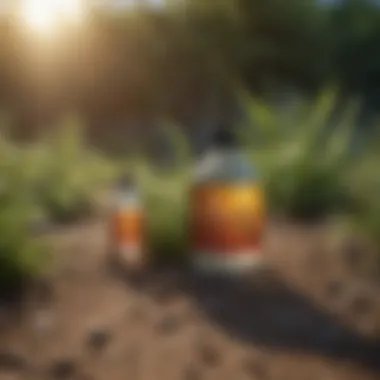Exploring Effective Chemical Agents for Pest Control


Intro
Pest control in agriculture is an essential area of focus, influencing crop yields and overall farm health. The use of chemical agents in this process has grown significantly due to the increasing demand for food and the necessity to protect crops from various pests. Understanding which chemical agents are most effective requires careful analysis of their properties, effectiveness, and impacts on the environment.
As stakeholders navigate the complexities of pest management, they look for methods that balance efficiency with safety. This article aims to comprehensively evaluate the key chemical agents used in pest control, providing insights that can guide agricultural practitioners and enthusiasts in their decision-making.
Topic Overview
Definition and Importance
Chemical agents, or pesticides, refer to substances designed to prevent, destroy, or control pests and are critical in modern agriculture. These agents play a vital role in ensuring the health of crops, which directly correlates with food production levels. The importance of selecting the appropriate chemical agent cannot be understated. It involves understanding its effectiveness against specific pests, potential toxicity to non-target organisms, and adherence to existing regulations.
Brief History and Evolution
The history of chemical pest control dates back centuries. Early agricultural practices involved natural substances, like plant extracts and mineral dusts. However, the introduction of synthetic chemicals in the 20th century marked a profound shift in pest management strategies. Substances such as DDT gained popularity for their effectiveness but later faced scrutiny due to environmental concerns. Over time, regulations evolved to ensure safety for both consumers and the ecosystem. Today, there is a strong movement towards sustainable approaches in chemical pest management, focusing on reducing negative impacts while maintaining efficacy.
Key Techniques and Innovations
Sustainable Farming Practices
Sustainable farming practices emphasize the careful selection and application of chemical agents. Integrated Pest Management (IPM) serves as one such technique, combining biological control, cultural practices, and judicious chemical use to manage pest populations while minimizing environmental impact. By relying more on natural predators and less on chemical interventions, farmers can achieve a healthier balance within their ecosystems.
Advanced Agronomic Technologies
Technological advancements are shaping the way chemical agents are utilized in pest management. Precision agriculture tools, such as GPS-guided equipment and drone-mounted sensors, allow for targeted application of pesticides. This increases efficiency and reduces waste and exposure to non-target organisms. Furthermore, data analytics plays a key role in predicting pest outbreaks and tailoring management strategies accordingly.
Practical Applications
Step-by-Step Guides
To effectively implement chemical agents in pest control, practitioners should follow a systematic approach:
- Identify the pest: Understanding the specific species helps to choose the right chemical.
- Evaluate the environment: Consider the surrounding flora and fauna to ensure a safe application.
- Select the appropriate agent: Review existing data on effectiveness and safety.
- Apply safely: Follow all regulatory guidelines, including dosage and timing.
- Monitor outcomes: After application, assess the effectiveness and any side effects.
Case Studies or Real-World Examples
Real-world applications provide valuable insights into the efficacy of chemical agents. One notable example involves the use of neonicotinoids in corn production. While effective at controlling specific pests, studies have shown adverse effects on pollinator populations, leading to subsequent regulatory amendments. Another case study could focus on the success of organic pesticides, which have gained traction in various agricultural sectors due to their reduced ecological footprint.
Effective pest control requires a nuanced understanding of both chemical efficacy and environmental safety. Failure to consider these factors can lead to long-term ecological consequences.
Preface to Pest Control Chemicals
Pest control is an essential aspect of agriculture that directly affects productivity and food security. The role of pest control chemicals is vital in managing the numerous challenges posed by various pests. Without effective chemical agents, crops can suffer significant losses, leading to economic crises for farmers and inadequate supply for consumers. Thus, understanding this topic is key to fostering knowledge among agricultural practitioners and eco-conscious stakeholders.
Chemical agents come in different forms, including insecticides, herbicides, fungicides, and rodenticides. Each agent serves a specific purpose and has unique mechanisms of action. Their applications range from eradicating harmful insects that affect crop health to eliminating weeds that compete for essential nutrients. The importance of these chemicals lies in their ability to enhance crop yields, ensuring that farmers can meet growing demands.
However, the use of chemical agents is not without considerations. There are risks involved, including potential health hazards to humans and detrimental effects on the environment. Understanding these factors is essential, as the wrong choice of chemical can lead to contamination of soil and water sources, as well as harm to non-target organisms.
Furthermore, regulations guide the use of these chemicals to ensure safety for both producers and consumers. Familiarizing oneself with these guidelines is crucial for effective pest management and compliance with legal standards.
In this article, we will thoroughly analyze the most effective chemical agents for pest control, providing insights on their advantages, limitations, and the latest advancements. The aim is to equip agricultural professionals with the tools needed for informed decisions that promote sustainable practices while ensuring productivity.
"Understanding pest control chemicals is not just about managing pests; it is about balancing efficacy, safety, and sustainability in agriculture."
By highlighting the significance of pest control chemicals, this article serves as a foundational piece for those engaged in agriculture, from experienced farmers to students keen on exploring pest management strategies.
Understanding Pests and Their Impact
Pests are organisms that compete with humans for resources. In agriculture, pests can lead to significant damage to crops, yielding detrimental financial losses. Understanding pests is crucial because it helps in developing strategies for their management. An effective pest management plan can lead to increased yield and better quality produce. Knowledge about pests allows farmers to select appropriate chemical agents and apply them effectively.
Common Types of Agricultural Pests
In agriculture, several types of pests play a crucial role in affecting crop health. Common agricultural pests include:
- Insects: Aphids, beetles, and caterpillars commonly affect various crops. These insects can consume plants, spread diseases, and interfere with crop development.
- Weeds: Unwanted plants that compete with crops for sunlight, water, and nutrients. Examples include dandelions and crabgrass.
- Diseases: Fungal, bacterial, and viral pathogens that cause diseases can devastate crops. For instance, potato blight significantly impacts potato crops.
- Rodents: Rats and mice can damage seeds and stored grains, resulting in economic losses for farmers.
The identification of these pests is essential. Different pests require different control strategies, including specific chemical agents.
Economic and Ecological Consequences
Pests have both economic and ecological impacts. Economically, pests can lead to:
- Crop Losses: Pests reduce yield, directly affecting income. Studies indicate that agricultural pests can cause up to 40% loss in yield for some crops.
- Increased Costs: The use of chemical agents incurs costs. Farmers must also invest in equipment and labor for pest management practices.
Ecologically, the presence of pests can disrupt local ecosystems. Pest-related consequences include:
- Biodiversity Loss: Non-target species may be harmed by pesticide sprays, affecting the local flora and fauna. This can disrupt food chains and lead to a reduction in biodiversity.
- Pesticide Resistance: Over time, pests can develop resistance to chemical agents, leading to a need for stronger chemicals and more intensive pest control measures.
"Sustainable pest management is not just beneficial; it is essential for maintaining ecological balance while securing economic stability for farmers."
Understanding these consequences emphasizes the need for integrated pest management strategies. By combining chemical agents with cultural, biological, and mechanical methods, farmers can achieve effective pest control while minimizing negative impacts.
Categories of Pest Control Chemicals
The categories of pest control chemicals are fundamental in addressing the diverse needs of pest management in various settings. Understanding these categories can assist agricultural practitioners in selecting the most suitable agents for their specific pest issues. Each class of chemicals targets different pests or plant diseases, providing a tailored approach to pest management practices. Their effectiveness, application methods, and safety considerations can significantly influence not only the success of pest control efforts but also the health of agricultural ecosystems.
Insecticides
Insecticides are chemicals that target insects. They aim to eliminate pests that can harm crops, livestock, and stored products. The effectiveness of insecticides varies widely, depending on the specific ingredients and their mode of action. For instance, neonicotinoids, a class of insecticides, are known for their neurotoxic effects on insects, which can lead to rapid mortality. However, it is crucial for users to understand resistance management to avoid pest populations from developing resistance to these chemicals.
Key considerations include:
- Choosing the right type based on the target insect.
- Following label instructions to minimize risks to non-target organisms.
- Implementing integrated pest management practices alongside insecticide use.


Herbicides
Herbicides are crucial for controlling unwanted plants or weeds that compete with crops for resources. The proper application of herbicides can improve crop yields, as they reduce competition. However, there are concerns about their environmental impact, including potential harm to beneficial plants and soil health. Glyphosate is one of the most widely used herbicides, effective against a range of any unwanted flora. Yet, its usage has sparked debate regarding ecological balance and human health risks.
Important factors to consider:
- Selectivity of the herbicide for specific weed species.
- Timing of application, which can influence effectiveness.
- Potential for herbicide resistance developing in weed populations.
Fungicides
Fungicides are utilized to manage fungal diseases that threaten plant health and agricultural productivity. Effective fungicide application can prevent and control outbreaks of diseases like powdery mildew or blight. There are several classes of fungicides, including sterol biosynthesis inhibitors and multi-site inhibitors, which work by multiple mechanisms to mitigate fungal growth. However, over-reliance on a single fungicide type can lead to resistance.
To ensure effective usage, one should:
- Rotational application of different fungicide classes.
- Monitor disease pressure carefully and apply fungicides only as needed.
- Integrate cultural practices to reduce disease incidence.
Rodenticides
Rodenticides are essential in controlling rodent populations, which can spread disease and damage to crops and property. The mechanisms of action often include anticoagulants that prevent blood clotting, leading to the death of rodents within a few days after ingestion. While effective, rodenticides pose risks to non-target species, including pets and wildlife, necessitating careful application and handling practices.
Critical considerations for rodenticides include:
- Using bait in targeted locations to reduce risks to non-target animals.
- Following specific guidelines to ensure safety during application.
- Monitoring for signs of rodent activity to assess the effectiveness of treatment.
Understanding these categories helps in the informed use of chemicals in pest control, aiming to balance efficacy with safety and environmental considerations.
Active Ingredients and Their Mechanisms
Understanding the active ingredients in pest control chemicals is crucial for assessing their effectiveness and safety. These active components are the substances responsible for the intended effects against various pests. By examining their mechanisms, one can determine how they interact with target organisms and what impacts they have on the surrounding environment. It is also essential to consider the benefits and potential drawbacks inherent in their use. A comprehensive understanding leads to more informed choices in pest management, promoting sustainable practices that align with environmental safety goals.
Synthetic Chemicals
Synthetic chemicals play a significant role in agricultural pest management. They are designed to target specific pests effectively, ensuring crops remain healthy and productive. Many synthetic insecticides, such as chlorpyrifos and pyrethroids, work by disrupting the nervous system of insects, leading to their death or incapacitation.
- Advantages:
- Considerations:
- High efficacy against a wide range of pests.
- Often faster acting compared to some natural alternatives.
- Usually available in various formulations, tailored for specific applications.
- Potential for environmental impact, including harm to non-target organisms.
- Risks of pesticide resistance developing in pest populations, leading to ongoing reliance on chemical applications.
In light of these factors, it is vital for farmers to remain diligent when utilizing synthetic chemicals, ensuring adherence to usage guidelines and integrating practices such as crop rotation to mitigate resistance issues.
Biopesticides
Biopesticides offer a more environmentally friendly approach to pest control. Derived from natural materials, such as plants, microbes, and minerals, they often have lower toxicity levels compared to synthetic chemicals. This makes them an appealing choice for eco-conscious farmers.
- Types of Biopesticides:
- Benefits:
- Microbial Pesticides: These contain living microorganisms that suppress pest populations. For instance, Bacillus thuringiensis is famous for its effectiveness against caterpillars.
- Plant-Incorporated Protectants: These are genetically engineered traits in plants, such as those found in certain Bt corn varieties, designed to resist pest infestations.
- Natural Extracts: Compounds derived from plants, like neem oil, exhibit insect-repelling properties and have minimal risks to non-target species.
- Lower environmental toxicity leads to improved biodiversity.
- Reduced risk of pests developing resistance, as they often target specific pest pathways.
- Contribution to integrated pest management (IPM) strategies, promoting sustainable agriculture.
However, biopesticides may require more careful application and management to achieve the desired results. Overall, they are a valuable addition to the pest control toolbox, particularly in a landscape increasingly focused on sustainable practices.
"The choice between synthetic chemicals and biopesticides often depends on specific situational needs in agriculture. Careful assessment is essential for making the best decisions for pest management."
Farmers and agricultural practitioners must weigh the effectiveness and potential risks of both synthetic chemicals and biopesticides to implement robust pest control strategies tailored to their unique environments.
Evaluating Chemical Effectiveness
Evaluating the effectiveness of chemical agents used in pest control is crucial in ensuring that agricultural practices are both productive and sustainable. This evaluation process helps in determining the best practices for controlling pest populations while minimizing costs and potential harm to non-target organisms. An effective evaluation involves multiple elements, including thorough efficacy studies, careful field trials, and reliable laboratory testing. Assessing chemical effectiveness not only aids in optimizing pest management strategies but also influences regulatory policies and consumer awareness regarding these chemicals.
Efficacy studies serve as a foundational component in evaluating chemical effectiveness. These studies measure how well a chemical agent can achieve its intended purpose, such as killing pests or preventing their growth. Various factors can affect efficacy, including application rates, timing, environmental conditions, and specific pest resistance levels. By understanding these variables, farmers can make more informed decisions about which agents to apply under specific circumstances.
Efficacy Studies
Efficacy studies provide systematic assessments of chemical agents, involving both controlled environments and real-world applications. These studies explore a range of factors that dictate how effective a chemical will be in practice. For instance:
- Target Pest Identification: Each chemical agent should clearly target specific pests. Identifying the pests beforehand ensures that the right chemical is used for the problem at hand.
- Application Rates and Methods: The amount of chemical used and how it is applied can significantly influence results. Understanding these factors helps in optimizing treatment methods.
- Timing: The timing of application is often critical. Applying a pesticide at the right moment can maximize efficacy by coinciding with the pest's lifecycle stage.
In abstract terms, efficacy studies reveal not just whether a chemical works, but under what conditions it performs best. This information is vital for any agricultural professional looking to adopt effective pest control practices while also adhering to safe usage guidelines.
Field Trials vs. Laboratory Testing
When evaluating chemical effectiveness, both field trials and laboratory tests play important roles. However, they serve different purposes and have their respective advantages and limitations.
- Field Trials: Field trials assess chemical agents in natural settings. The complexities of soil types, pest dynamics, and weather conditions affect the results. Field trials help in understanding real-world implications of chemical use.
- Laboratory Testing: Laboratory testing provides controlled conditions that isolate specific variables. This method is useful for initial screening of chemical efficacy before moving to larger trials in the field. However, results may not always translate well to field conditions.
Both approaches are essential in the comprehensive evaluation of chemical agents. Combining insights from both field trials and laboratory tests can lead to a clearer understanding of how effective a chemical might be in practical applications.
"Understanding the effectiveness of pest control chemicals is not merely about assessing their ability to kill pests. It is about striking a balance between efficacy, safety, and environmental responsibility."
In summary, evaluating chemical effectiveness is a multi-faceted process that informs agricultural practices. Efficacy studies, field trials, and laboratory testing each contribute essential knowledge. They allow farmers and practitioners to select the best options for pest control, promoting efficiency and safety in agricultural operations.
Safety Considerations in Chemical Pest Control
Safety considerations in the use of chemical pest control agents are paramount. Understanding the associated risks and impacts is essential not only for the health of farmworkers but also for consumers and the environment. This section will detail the important elements of safety in chemical usage, emphasizing both human health risks and environmental impact.
Human Health Risks
Human health risks from chemical pest control agents are a significant concern. Pesticides can pose serious health threats if not handled or applied correctly. There are various routes of exposure, including inhalation, skin contact, and ingestion. Acute exposure may lead to immediate symptoms such as headaches, nausea, and irritation. Chronic exposure could develop over time into more serious ailments including respiratory dysfunction, reproductive issues, or even cancer.
The risks are not just limited to those who apply these chemicals directly. Workers involved in the harvest may also be affected, as residues can remain on crops. Proper protective gear, such as gloves, masks, and goggles, is crucial to mitigate these risks.
Farmers and agricultural workers need to be thoroughly educated about safe handling practices. Label instructions should be meticulously followed to avoid dangerous accidents. Additionally, training sessions on the application and storage protocols can contribute to a safer working environment.


Environmental Impact
Chemical pest control methods also have profound environmental impacts. The application of these agents can contaminate soil, water, and non-target species, leading to a disruption in ecosystems. For instance, runoff during rainfall can carry pesticides into rivers and lakes, harming aquatic life and potentially entering human water supplies.
Moreover, the overuse of certain chemicals can lead to pesticide resistance in pest populations. This can trigger a cycle of increased chemical application, further exacerbating environmental degradation. Additionally, beneficial insects, such as bees and butterflies, play vital roles in pollination and biodiversity. Pesticides can harm these populations, affecting food production and ecosystem balance.
"Sustainability in pest control must prioritize minimizing environmental harm while effectively managing pest populations."
To address these issues, methods such as Integrated Pest Management (IPM) advocate for the combination of chemical and non-chemical strategies. By employing biopesticides and cultural practices, farmers can reduce reliance on harmful chemicals while still achieving effective pest control.
Regulatory Framework Governing Chemical Use
The regulatory framework governing chemical use in pest control is a crucial aspect of agricultural practices. It ensures that chemicals are used responsibly and are effective in managing pest populations while protecting human health and the environment. This framework provides guidelines and standards that help farmers make informed decisions about their pest management strategies.
Understanding this framework is essential for several reasons:
- Safety and Efficiency: Regulations are designed to guarantee that chemical agents are safe for human use and do not cause significant harm to the environment. They help in selecting chemicals that provide effective control of pests while minimizing risks.
- Compliance: Farmers need to comply with local, national, and international regulations to avoid legal consequences. Non-compliance can lead to fines or loss of license to operate.
- Market Access: Adhering to regulations is often mandatory to access specific markets. Retailers and consumers increasingly demand that agricultural practices are sustainable and ethical.
- Research and Development: Regulatory frameworks often guide research into new pest control technologies and practices. They help prioritize which substances can be tested and brought to market.
Therefore, it is vital for agricultural practitioners to stay informed about relevant regulations and how they affect pest control decisions.
National Regulations
National regulations on pest control chemicals vary from country to country. Each government sets its policies based on public health, environmental concerns, and agricultural needs. In the United States, for instance, the Environmental Protection Agency (EPA) regulates pesticide use to ensure safety and effectiveness. Before any chemical can be marketed, it undergoes a rigorous evaluation process to assess its potential risk.
Some common elements of national regulations include:
- Registration of Pesticides: Chemicals must be registered with appropriate governmental authorities. This process includes labelling requirements, safety data sheets, and usage guidance.
- Monitoring and Enforcement: Agencies conduct regular inspections and enforce compliance with laws and regulations. This can involve checks on agricultural operations to ensure safe use.
- Public Reporting: Governments often require that pesticide use data be made publicly available. This transparency promotes accountability and better consumer awareness.
International Agreements
International agreements also play a significant role in shaping the regulatory landscape for pest control chemicals. Organizations such as the United Nations Food and Agriculture Organization (FAO) and the World Health Organization (WHO) lead efforts to create a harmonized approach to pest control worldwide. Agreements aim to protect human health and the environment by minimizing the risks associated with chemical use.
Key aspects of international agreements include:
- Standards Development: These agreements often establish global standards for evaluating the safety and efficacy of pest control chemicals, ensuring a consistent approach across borders.
- Bilateral and Multilateral Agreements: Countries may enter into agreements to share information, technology, and best practices for pest management.
- Capacity Building: International collaboration is essential for developing countries to improve their regulatory frameworks. Training and resource sharing pave the way for sustainable pest control practices.
"Adhering to both national and international regulations is not just a compliance matter; it is a critical component of sustainable agriculture."
Thus, the regulatory framework governing chemical use is not only about rules but also about promoting safe and sustainable agricultural practices globally.
Advancements in Pest Control Chemicals
In recent years, significant advancements have emerged in the field of pest control chemicals. These innovations address the growing demand for more effective and sustainable solutions to combat pests in agricultural practices. The importance of these advancements cannot be overstated, as they hold the potential to enhance crop yield, safeguard human health, and minimize environmental pollution. With the increasing resistance of pests to traditional chemicals, the development of new strategies and technologies is crucial for successful pest management.
This section focuses on two main areas of advancement: nanotechnology applications and smart pesticides. Each of these advancements offers unique benefits and considerations that are vital for agriculture farmers and enthusiasts in selecting suitable pest control methods.
Nanotechnology Applications
Nanotechnology has revolutionized various sectors, and pest control is no exception. By manipulating materials at the nanoscale, researchers have developed nanopesticides that can target specific pests while reducing the impact on non-target organisms. The benefits of using nanotechnology in pest control include:
- Enhanced Efficacy: Nanoparticles can penetrate pest exoskeletons more effectively than conventional pesticides, leading to improved lethality.
- Controlled Release: Nanopesticides can be designed to release active ingredients in a controlled manner, which minimizes the frequency of application needed.
- Reduced Chemical Use: Because of their efficiency, nanopesticides can significantly lower the amount of chemicals introduced into the environment.
Applicators must take into account that while nanotechnology offers great promise, it also poses certain challenges. For instance, the long-term environmental effects of nanoparticles are still not fully understood. Regulating the use of these products will be crucial to ensuring that they do not contribute to unforeseen ecological issues.
Smart Pesticides
Smart pesticides represent another front in the ongoing battle against agricultural pests. These chemicals are designed to respond to environmental triggers, enhancing their effectiveness while decreasing risks to beneficial organisms. Key features of smart pesticides include:
- Precision Application: Smart pesticides can detect specific pest populations and only activate when pests are present, thus minimizing unnecessary exposure to beneficial species.
- User-Friendly Technology: Many smart pesticide formulations come with integrated sensors or software, making it easier for farmers to monitor pest activity and adjust applications accordingly.
However, the adoption of smart pesticides requires a certain level of technological familiarity. Farmers must understand how to interpret the data provided by these systems to maximize benefits.
"Advancements in pest control technology, such as nanotechnology and smart pesticides, not only improve the efficiency of pest management but also promote sustainable agricultural practices."
Integrated Pest Management (IPM) Approaches
Integrated Pest Management (IPM) is a crucial approach within the field of pest control. This method emphasizes a holistic view, integrating various management tools and practices. By combining chemical and non-chemical strategies, IPM aims to achieve effective pest control while minimizing risks to human health, beneficial organisms, and the environment. Implementing IPM is not only effective but also supports long-term sustainability goals that address both agricultural productivity and ecological balance.
Combination of Chemical and Non-Chemical Strategies
The combination of chemical and non-chemical strategies is at the heart of IPM. Chemical agents, such as insecticides and herbicides, play an important role in rapidly controlling pest populations. However, reliance solely on these chemicals can lead to resistance and environmental harm. Therefore, non-chemical strategies, such as cultural practices, biological control, and habitat manipulation, are essential components.
- Cultural Practices: These include crop rotation, intercropping, and selecting resistant crop varieties. By altering the growing environment, pests can be deterred effectively.
- Biological Control: This method employs natural predators or parasites to manage pest populations. For example, ladybugs are effective against aphids.
- Habitat Manipulation: This involves modifying the environment to make it less conducive to pest establishment. Strategies may include adjusting planting timing or modifying irrigation practices.
By effectively combining these approaches, farmers can reduce the need for chemical inputs. This not only enhances pest control outcomes but also promotes environmental health.
Long-term Sustainability Goals
IPM aligns closely with long-term sustainability goals in agriculture. By adopting an IPM approach, farmers cultivate a resilient agricultural system that can withstand pest pressures without detrimental effects on the ecosystem. Sustainability in pest management involves several key aspects:
- Biodiversity: Preserving a range of species within agricultural systems helps to maintain ecological balance, which in turn supports pest regulation.
- Soil Health: Practices that reduce chemical inputs are beneficial for soil microorganisms. Healthy soils contribute to productive crops, further enhancing resilience against pests.
- Water Conservation: Effective pest management strategies often include practices that minimize water use, ensuring that agricultural practices are sustainable over time.
By adopting IPM, farmers not only address immediate pest issues but also contribute to the overall health of their farming systems.
In summary, Integrated Pest Management (IPM) approaches focus on a myriad of strategies that includes both chemical and non-chemical methods. The benefits of this integrated approach extend beyond pest control, promoting sustainability and resilience in agricultural systems.
Case Studies in Effective Chemical Pest Control
Understanding the role of chemical agents in pest control is vital for agricultural success. Case studies provide valuable illustrations of real-world applications, showcasing both successes and failures. These studies not only highlight effective strategies but also reveal the underlying principles that can guide practitioners in their pest management decisions.
Successful Applications in Agriculture
Many agricultural practices involve the use of chemical agents, and some of these have proven exceptionally effective. For example, the introduction of thiamethoxam, a neonicotinoid insecticide, has shown promising results in controlling aphid populations in various crops. Research indicated that its application led to a significant reduction in pest density, allowing crops to flourish without excessive loss.


Similarly, glyphosate-based herbicides have transformed weed management in fields since their introduction. Their efficiency against a broad range of weed species has made them a staple for farmers. Various studies have documented yields increase when glyphosate is part of the weed management regimen.
Benefits from these chemical applications include:
- Increased Yields: Higher production due to pest and weed control.
- Cost Effectiveness: Reduced need for labor-intensive methods have lowered operational costs.
- Promoting Crop Health: Enhanced vigor of plants leads to better resistance against diseases.
These examples underscore the critical role chemical agents can play when applied appropriately.
Lessons Learned from Failures
However, not all applications of chemical agents have produced positive outcomes. Some case studies reveal shortcomings that have led to pest resistance or serious ecological concerns. A notable instance involves the use of chlorpyrifos, an insecticide that was once widely used to control a variety of pests. Over time, many pest populations developed resistance, leading to diminishing returns on agricultural produce.
Moreover, the use of certain herbicides has raised significant environmental concerns. The case of atrazine, one of the most commonly used herbicides, has highlighted the potential for groundwater contamination. Studies have shown harmful effects on aquatic life when the chemical runoff enters bodies of water.
Key lessons include:
- Monitor Resistance: Continuous monitoring of pest populations helps in adjusting strategies proactively.
- Regulating Usage: Understanding local environmental regulations can prevent harmful applications.
- Diversifying Techniques: Integrated pest management strategies can mitigate the risks associated with over-reliance on chemical agents.
Effective pest control requires a balanced approach that takes into account not just productivity, but environmental sustainability.
These case studies serve as a cautionary tale and reinforce the necessity of research, monitoring, and adaptability in pest control practices. Combining both successful applications and aware of past failures enable practitioners to make informed decisions that benefit their crops while also protecting the environment.
Consumer Awareness and Education
In recent years, the importance of consumer awareness in the context of pest control chemicals cannot be overlooked. Increased knowledge among consumers leads to more informed decisions regarding the use, safety, and potential environmental impact of these chemical agents. As various agents are utilized in agriculture, horticulture, and households, individuals must understand not only their effectiveness but also their risks and benefits. This section explores key elements of consumer education related to pest control chemicals.
Educating consumers about pest control products fosters a better understanding of their role in integrated pest management. Awareness allows users to make choices that align with ecological considerations and health impacts. Furthermore, informed consumers can contribute to dialogue surrounding regulatory standards and best practices in chemical application.
"An informed consumer is essential for ensuring the responsible use of pest control chemicals. Awareness leads to safety, efficacy, and overall sustainability in pest management."
Focusing on several important aspects can enhance consumer knowledge:
- Chemical Ingredients: Understanding what is in pest control products enables users to choose agents based on effectiveness and safety. Knowledge of active ingredients and their mechanisms can define consumer choices.
- Application Guidelines: Proper techniques for applying pest control chemicals are critical to minimize exposure risks to humans and non-target organisms. Consumers must learn to follow all label instructions carefully.
- Storage and Disposal: It is vital for users to understand safe storage practices to avoid accidental poisonings and to follow recommended disposal procedures to prevent environmental contamination.
Adopting an awareness-driven approach allows consumers to advocate for better practices in their communities, promoting a culture of responsible use among fellow stakeholders.
Label Reading and Safety Practices
Reading product labels is an essential skill for any consumer of pest control chemicals. Labels provide critical information about the product, including safety precautions, application methods, and potential health risks. Understanding how to interpret labels can significantly reduce risks associated with chemical exposures.
When reading labels, consumers should look for key pieces of information:
- Safety Warnings: Identify hazards associated with the chemical, such as toxicity levels to humans and the environment.
- Usage Instructions: This section details how, when, and where to apply the chemical for optimal results.
- Environmental Precautions: Information on mitigating potential harm to beneficial insects, soil, and water sources is often included. Consumers should prioritize products that align with sustainable practices.
Safety practices must also complement label reading. This includes wearing protective equipment, employing proper application techniques, and maintaining awareness of wind conditions to prevent drift.
Advocacy for Responsible Use
Advocacy plays a crucial role in promoting responsible use of pest control chemicals. Consumers who are informed about the potential risks and benefits are better positioned to voice their concerns on a local and global scale. By engaging in advocacy, they can press for regulations that protect health, the environment, and agricultural integrity.
Factors involved in advocacy for responsible use include:
- Community Education Programs: Initiatives aimed at educating farmers, gardeners, and the general public about safe chemical use.
- Collaboration with Regulatory Agencies: Consumers can work alongside policymakers to ensure that regulations reflect both safety and efficacy in chemical applications.
- Promoting Organic Options: Advocating for organic or less toxic alternatives not only caters to health-conscious consumers but can also drive innovation in pest control chemical development.
Advocacy fosters collaboration between consumers, agricultural practitioners, and scientists, aligning pest control practices with broader sustainability goals. Through education and active involvement, consumers can contribute to the evolution of pest management strategies that prioritize ecological balance and public health.
Future Directions in Pest Control Chemicals
The future of pest control chemicals is critical for agricultural efficiency and sustainability. As the global demand for food rises, innovative chemical solutions must evolve to meet these challenges. This section explores emerging trends and collaborative efforts that are shaping the next generation of pest control strategies.
Emerging Trends in Research
Research in pest control chemicals is at a pivotal point, with a focus on sustainability and effectiveness. One notable trend is the development of targeted delivery systems. These systems use advanced technology to apply chemicals precisely where needed. This reduces the overall chemical usage, minimizing potential harm to other organisms and the environment.
Another significant avenue is the enhancement of biopesticides. These products, derived from natural materials, are gaining traction. They often have fewer adverse effects on non-target species. Current research aims to improve their efficacy and shelf-life, making them more viable alternatives to traditional synthetic chemicals.
Beyond biopesticides, innovative formulations are evolving. Nanotechnology is increasingly being integrated into pest control. This approach allows for smaller particles that can deliver chemical agents more effectively at lower volumes. It could also extend the effectiveness of treatments, reducing the need for frequent applications.
In addition to these developments, there is a significant push towards multi-modal treatments. This method combines various agents for more effective pest management. For instance, employing a mix of biopesticides with conventional insecticides can potentially enhance overall effectiveness while mitigating resistance development in pests.
"The integration of nanotechnology into pest management could mark a turning point in how we approach agricultural challenges."
Collaborations Between Scientists and Farmers
Collaboration is key to translating research findings into practical applications. Scientists and farmers must work together to ensure that the innovations are both effective and feasible. Partnerships can facilitate more applied research, helping to address specific challenges faced in various farming practices.
Farmers provide essential real-world insights that can guide laboratory research. Their hands-on experience can lead to better-targeted research questions. For instance, farmers may identify particular pest outbreaks that require urgent attention, prompting scientists to focus their research efforts appropriately.
Furthermore, educated farmers play a crucial role in testing new chemicals or strategies on a smaller scale before broader implementation. This approach helps assess both the effectiveness and safety of new pest control solutions. By actively participating in the research process, farmers can offer feedback that leads to improvements in chemical formulations, ensuring that they meet practical agricultural needs.
Engagement with cooperative extension services can further bridging the gap between research and practice. These organizations often facilitate workshops or field demonstrations to educate farmers about new developments in pest control chemicals. By increasing awareness and knowledge, they can foster a more informed agricultural community willing to adopt innovative approaches.
In summary, the future paths of pest control chemicals hinge on ongoing research cooperation. Propelling advancements in technology while ensuring farmer involvement will lead to responsible, effective, and sustainable pest management strategies.
The End and Recommendations
In the realm of pest control, the significance of chemical agents cannot be understated. Their efficiency in managing pest populations directly correlates with agricultural productivity and food security. This conclusion aims to encapsulate the key insights from the previous sections, reinforcing the critical aspects while providing actionable recommendations.
First, the efficacy of various chemical agents hinges on understanding their active ingredients and mechanisms. Synthetic chemicals often demonstrate rapid action, while biopesticides provide a more environmentally friendly alternative with a slower but sustained impact. This calls for careful consideration of the pest species and environmental conditions when selecting a chemical agent.
Additionally, the importance of regulatory frameworks cannot be overlooked. Comprehending national and international regulations helps ensure compliance and promotes sustainable pest management practices. Farmers must stay informed about these rules to avoid misuse and potential legal repercussions.
The implications of chemical use extend into human health and environmental safety. Awareness of risks, such as potential health hazards to users and ecosystems, should be paramount. This understanding leads to better practices, like following label instructions accurately and employing protective measures during application.
Key Recommendations:
- Educate and train personnel on safe handling of chemical agents.
- Opt for integrated pest management (IPM) strategies that blend chemical and non-chemical methods for long-term sustainability.
- Engage in ongoing research and development to stay updated on new advancements, such as smart pesticides and nanotechnology applications.
As we move forward into an era of enhanced pest management strategies, collaboration among scientists, farmers, and regulatory bodies will be essential. This partnership can drive innovation, ensure safety, and optimize pest control measures for the future.
"Informed decisions in pest control can lead to sustainable agricultural practices and increased food security."



